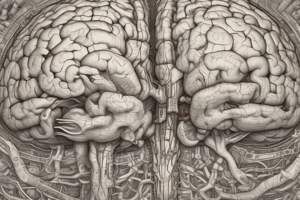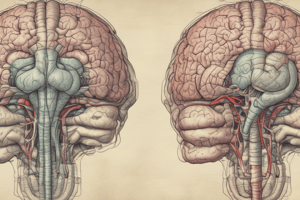Podcast
Questions and Answers
Which part of the brain is responsible for language production?
Which part of the brain is responsible for language production?
- Cerebellum
- Broadman’s area
- Broca’s area (correct)
- Basal ganglia
How many lobes are present in each hemisphere of the cerebrum?
How many lobes are present in each hemisphere of the cerebrum?
- 4 lobes (correct)
- 2 lobes
- 5 lobes
- 3 lobes
What is the function of the basal ganglia in the brain?
What is the function of the basal ganglia in the brain?
- Controls motor movement and cognition (correct)
- Responsible for sensory perception
- Responsible for language processing
- Hierarchically organizes language
What does the term 'aphasia' refer to?
What does the term 'aphasia' refer to?
What is the primary focus of the equipotentiality view of brain function?
What is the primary focus of the equipotentiality view of brain function?
What is the advantage of using fMRI over EEG and MEG?
What is the advantage of using fMRI over EEG and MEG?
Which technique uses concentration of neurotransmitters instead of blood flow?
Which technique uses concentration of neurotransmitters instead of blood flow?
What is the main challenge of identifying the source of underlying signal in EEG and MEG?
What is the main challenge of identifying the source of underlying signal in EEG and MEG?
Which neuroimaging technique provides image of active and less active brain areas using BOLD contrast?
Which neuroimaging technique provides image of active and less active brain areas using BOLD contrast?
What is the main advantage of using ERP in studying neural activity?
What is the main advantage of using ERP in studying neural activity?
Flashcards are hidden until you start studying
Study Notes
Brain Functions and Anatomy
- Broca's area in the frontal lobe is primarily responsible for language production.
- Each hemisphere of the cerebrum contains four lobes: frontal, parietal, temporal, and occipital.
Basal Ganglia and Language Disorders
- The basal ganglia play a critical role in movement regulation, motor control, and cognitive functions.
- Aphasia refers to a language disorder affecting speech production or comprehension, typically due to brain damage.
Brain Function Theories
- The equipotentiality view suggests that different areas of the brain can take over functions if certain areas are damaged, emphasizing brain plasticity.
Neuroimaging Techniques
- fMRI (functional magnetic resonance imaging) measures brain activity by detecting changes in blood flow, offering advantages over EEG (electroencephalography) and MEG (magnetoencephalography) such as better spatial resolution.
- Neurotransmitter concentration measurement, rather than blood flow, is the focus of Magnetic Resonance Spectroscopy (MRS).
- A major challenge of EEG and MEG is pinpointing the precise source of signals due to the complex nature of the electrical activity.
Measuring Brain Activity
- fMRI utilizes BOLD (Blood Oxygen Level Dependent) contrast to visualize active and less active brain regions.
- Event-Related Potentials (ERP) are beneficial for studying neural activity as they provide high temporal resolution, allowing detection of rapid brain responses to stimuli.
Studying That Suits You
Use AI to generate personalized quizzes and flashcards to suit your learning preferences.




